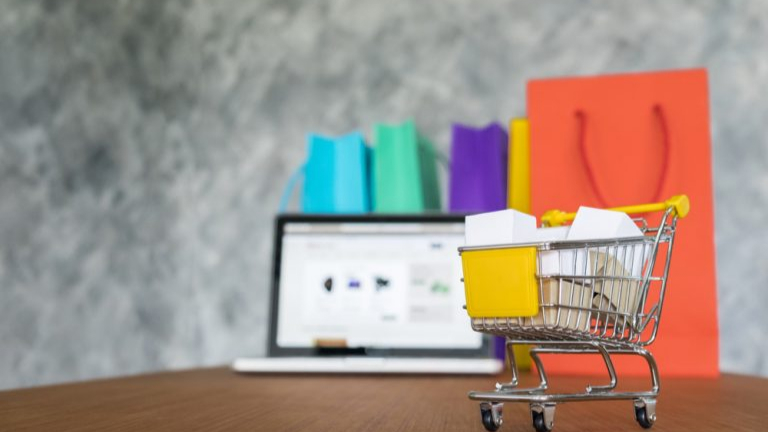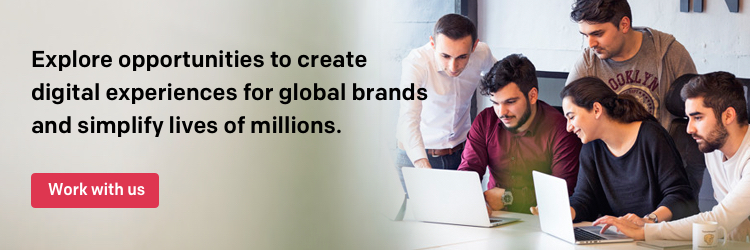How many connected devices do you own? Chances are, even accounting for smart speakers or smartwatches, the number may be in the region of 4 or 5. However, by 2030 it is believed that each human will have more than 20 connected devices, thanks to hyperconnectivity. The effects it will trigger points to a world where everyone and every ‘thing’ will be connected, intelligent, and talking to each other.
The term hyperconnectivity has been used for many years in the context of interconnected devices or merely being ‘always online’. In the near future, it will take on an altogether different meaning. 5G mobile networks, the Internet of Things, and big data will trigger an explosion of smart cities, homes, and workplaces. In turn, these will result in millions of connected devices, smooth data flows, and networks. This never before convergence will give a boost to not just the adoption of digital experience (DX) across enterprises but the nature and scope of such.
DX beyond mobile apps & websites
Today, DX still largely refers to the nature of customer interaction on websites, mobile apps, and such. Undoubtedly these have simplified our lives. For example, a few airports have offered self-check-in kiosks and automated boarding through facial recognition for some time now. Native apps of airlines such as United are more accessible to people with visual disabilities.
But over the last few years, especially in the post-COVID world, forward-thinking enterprises have re-oriented themselves to adopt business processes that have digital at the core, in order to improve the performance in an integrated fashion. A bank may employ Artificial Intelligence to assess the credit risk of consumers and make personalize offerings or communication. At an airport, inter-connected processes such as automated identity-screening and deployment of the Internet of Things can ease the customer experience beyond just a well-designed mobile app. These can help in airport navigation, tracking checked luggage, and smart retail operations.
The key aspects of our hyperconnected world which will impact the way enterprises design their services and accelerate the growth of DX will be: 5G-powered applications, Cloud, E-commerce, Artificial Intelligence, and Cybersecurity. We have already seen how e-commerce has re-shaped post the COVID-19 pandemic. Aside from essentials such as groceries & pharmaceuticals many industries have adapted to re-wire their business for the remote world. They have understood the core emotions of the customer and offer reassurance of hygiene practices, virtual tryouts, and no-touch delivery. Video streaming, which was only associated with media & entertainment is now part of retail therapy too.
Connected Living and its impact
Machine Learning and AI have already begun to play a role in crafting digital experiences across industries. In the hyperconnected world, such technologies along with conversational computing and asset tracking will have a far-reaching impact. In many business value chains, logistics plays a critical role. Tracking of assets such as a package to determine which truck, vessel, or location it is in, will deliver efficiencies and peace of mind. Where needed, sensors can detect vital information such as temperature (in a cold chain) or other key parameters and keep the various stakeholders informed. Such technologies can also help in creating customer delight: over time, the system can evolve to offer predictive logistics and get into pre-emptive shipment mode. If a customer orders a shaving kit on a regular basis, imagine the delight when an order arrives within minutes of placing it, instead of days – as the system would have pre-empted the order. Over the last few years, we would have read about smart refrigerators that ‘detect’ what needs to be ordered and so on. Such concepts need not be fantasy anymore as smart devices and logistics can make these a reality. Warehouses, fulfillment centers, and the entire value can get more efficient thanks to the ripple effects of hyperconnectivity.
The two places where we spend most of our time – home and work will transform beyond recognition. According to Frost & Sullivan, ‘the future home will become a ‘central hub’ for connected living’. Apple Watch is already powering Apple Fitness+, a service that then needs an Apple device to stream your personalized workouts. On-demand workspaces, entertainment centers, and Telehealth centers are also likely to emerge at home. The post-COVID world has also seen a demand for contactless biometrics and security technologies. All of these will get more personalized as data analytics, AI, augmented and virtual reality (AR/VR) and advanced computing come into play.
A hybrid work structure is likely to be a reality in the near future. The result? The need for digital, automated workflows (which eliminate manual, repetitive tasks) will rise leading to more productivity and employees with a sense of accomplishment. The pressure on government services to make the most of hyperconnectivity and create smart cities also offers opportunities for enterprises. Monitoring of physical structures such as bridges, friction-free citizen services, safe public places, connected cars, smart supply of essentials such as water & electricity have all critical digital components which need a combination of strategy, design, engineering, and analytics.
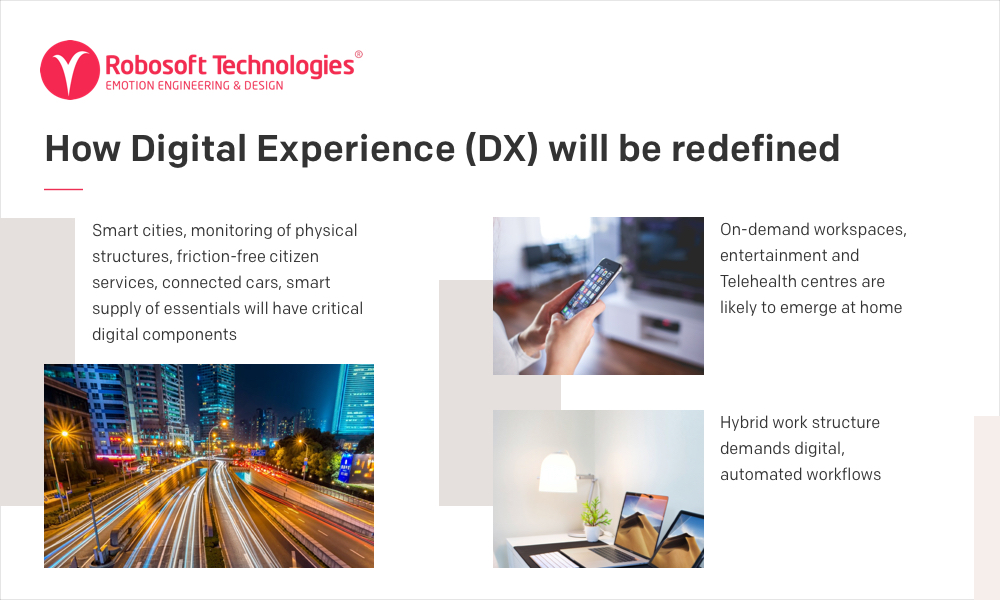
The possibilities of a hyperconnected future are limitless. It would mean immersive, personalized experiences for customers across shopping, Telehealth, gaming, and real-time collaboration. The explosion of data in the hyperconnected digital enterprise has implications in security too. But the positives of a connected ecosystem lie in making our lives simpler and better.
At Robosoft, our mission is simplifying lives with delightful digital experiences. Our talented team of product strategists, designers, software engineers work towards driving this mission.
In this interview-based series, we chat with our ‘behind the scenes’ experts – to know more about their values and inspirations. We also try and understand what drives them to create digital solutions that touch the lives of millions and drive business results.
Today, let us get to know Pramila S Shetty Senior Test Engineer at Robosoft. Pramila started her career with Robosoft and has been a part of our team for over 13 years now.
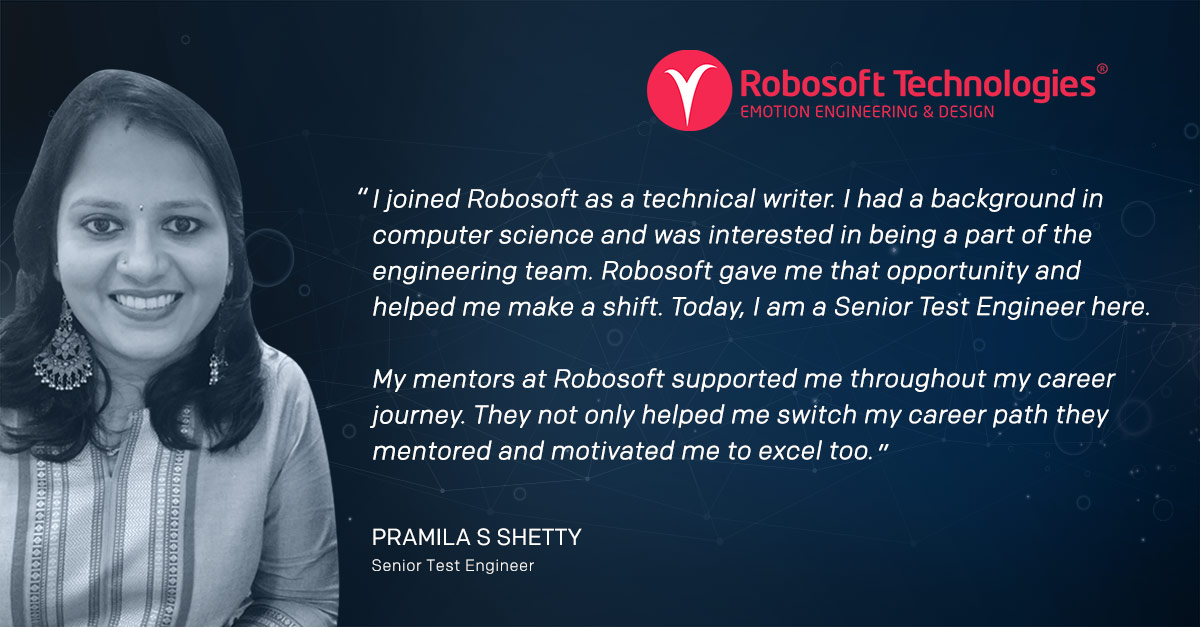
Q: Can you tell us about yourself – your family, interests, and work philosophy?
I was born in Udupi and spent my childhood in Mumbai. I moved back to Udupi when I was in High school, and completed my studies there. My childhood was spent in the lush green rural areas of Udupi since my family had an agricultural background. I loved growing up amidst the greenery and that has helped me appreciate nature and stay connected to my roots.
I am an optimistic person and always try to look at the positive side of any circumstance. I truly believe in persistence and hard work and live by the motto ‘try and try until you succeed’. This philosophy helps me to chase after my dreams and not give up easily.
My favorite hobby is spending time and goofing around with my year-and-half old kid. I like singing and dancing too, it helps me rejuvenate after a long day. I love to wear the chef’s hat in my free time and experiment with new recipes. It gives me immense joy when the dish turns out exactly as I wanted and everyone enjoys it too.
Q: What made you choose Robosoft & what is it that inspires you?
I was in college when the Robosoft Udupi campus was being built. I was really fascinated by this IT company operating from our small town of Udupi. I and my friends often discussed how amazing it would be to get an opportunity to work here. And, as luck would have it, I did get that chance.
After my BCA I got interviewed and joined Robosoft as a member of the Creative Works Department as a technical writer. As I learnt more, my interest grew in moving to the technical side of things and be a part of the engineering team that creates these amazing digital experiences. Robosoft gave me that opportunity and helped me make a shift. I moved to the SQA team. In parallel, I also completed my Masters’s degree and got a chance to join the QA and testing team.
My mentors at Robosoft supported me throughout my career journey. They not only helped me switch my career path and move to QA, they mentored me and motivated me to excel too.
Q: How has work from home been for you? What is it like to manage home and work responsibilities? Any advice to peers?
The initial days of WFH when there were strict lockdowns were quite challenging. I had to adapt to a completely different routine than what I was used to. Besides managing a little kid, work, and household chores between just me and my spouse did become difficult. But slowly we figured a routine and processes to manage everything efficiently. I created a proper schedule for my project as well as household work. This helped me manage my responsibilities. Also, being flexible in setting my routine helped, I did not bother too much if day-to-day activities weren’t happening as before, I adapted to the situation. This helped me be at mental peace.
My advice to everyone working from home would be to have a planned set of tasks to complete each day and to prioritize the tasks. Know what is expected of you, and put in your best efforts. Also, remember to not be too tough on yourselves, and take time out to de-stress by doing whatever you enjoy doing like following your hobby or spending time with family.
Q: Your advice to students & freshers exploring opportunities in this field?
My advice to freshers would be to take guidance from their seniors who are already in the field or lecturers and be informed about the career scope, before choosing a stream of specialization. However, do find out what technologies you are really interested in – and gain expertise in that, rather than just following the trend. To succeed in a field, one should be interested in what they are doing.
Technology is always evolving. So to grow and succeed you should keep upskilling and be up-to-date with the latest technologies. Never become complacent with your current knowledge, since technologies become obsolete in a matter of years.
Q: In your view, what is the scope of this industry in the years to come?
Although the Covid-19 pandemic had led to a slowdown of all industries including IT, the economy has slowly started recovering. The IT sector sustained and grew and will continue to do so, since automation is one aspect that almost every other industry relies upon, be it Banking, Media, or others.
Also with the advent of new technology trends like Artificial Intelligence, Machin Learning, Virtual Reality, Augmented Reality, the IT industry will see good growth in the years to come.
In the ‘new normal’ the rules of how and why consumers shop changed drastically. Some of these shifts included – reliance on e-commerce channels, less confidence about in-person or in-store shopping, seeking safety and hygiene assurance from physical stores, and a rise in online deliveries for grocery and pharmacy products.
The world is slowly bouncing back and consumers are seeking to go back to older ways. Almost two-thirds of people (63%) have dined in a restaurant during COVID-19, indicating a demand for alternatives to eating at home. People working from home want the flexibility to work from both office and home. There’s also been a rise in outdoor activities – skis and snowshoes went flying off the shelves this year in January. After the panic buying of essential items, people are now back to normal buying habits in terms of quantities of purchase.
But some of the behavioral shifts that brought convenience in people’s lives during the pandemic will continue to stay. 76% of consumers switched to exercising more at home during COVID-19, and of those, 66% say they prefer it. During the pandemic, people shifted to home cooking and healthier food – a trend likely to continue. Recent USDA reports point to a surge in demand for healthy, whole foods – especially ones seen as immune-system boosting and in wealthier countries, this includes sharp increases in demand for organic food.
The pandemic accelerated the digital transformation of retail and a shift to e-commerce channels by at least 5 years. Delivery services also re-invented their digital experiences with services like contactless deliveries, drones, digital payments, and more. Delivery services have fastened their pace of digital shift to meet the evolving customer needs.
Just before the pandemic, Lowe’s underwent a major website overhaul to grow its e-commerce business. The store created a seamless omnichannel experience by investing in supply chain, IT, and leadership development. This well-timed digital overhaul, helped Lowe’s to launch curbside pickup in just three days during the pandemic.
Wendy’s revamped its website and app to create a more robust ordering system that can be updated in real-time. With uncertain supply chains, Wendy’s could easily remove certain menu items that aren’t available – so customers don’t place an order which can’t be fulfilled. The company expanded its delivery services and used its communication channels to alert customers of contactless ordering and payments for a more seamless digital experience.
The digitization efforts by retailers during the pandemic can be categorized into: Strategic changes, Operational changes, and Engagement/Communication methods. In our webinar Mart to cart role of digital experiences in online delivery, we discussed the evolving consumer behavior and key factors that can help delivery services in crafting great digital experiences.
Watch the webinar video here.
The role of multi-experiences in retail
In a post-pandemic world, digital experiences have come to play a critical role in creating brand preference. Delivering great customer experiences (CX) has become imperative for all enterprises.
“In the digital world, it is said that winning consumer’s attention is important. But I would argue that beyond mere attention, enterprises should strive to win consumer trust – as that is what leads to retention and consumer loyalty. Design can play a role in retaining customers, especially in businesses where subscription and repeat purchases are critical. In the post-COVID world, it is imperative that CXOs embrace the multiexperience mindset and craft effortless and seamless experiences that enable customer delight and win their trust.’’
~ Ravi Teja Bommireddipalli, CEO, Robosoft Technologies
For a long time, the retail industry has focussed on creating omnichannel experiences. However, in the new normal creating multi-experiences is an imperative not just for the retail sector but for enterprises across industries. What this means is retail enterprises will have to move beyond enabling consumers to engage anytime and anywhere to allowing them to interact in any way that is most convenient for them – online store, mobile app, voice, social media, etc.
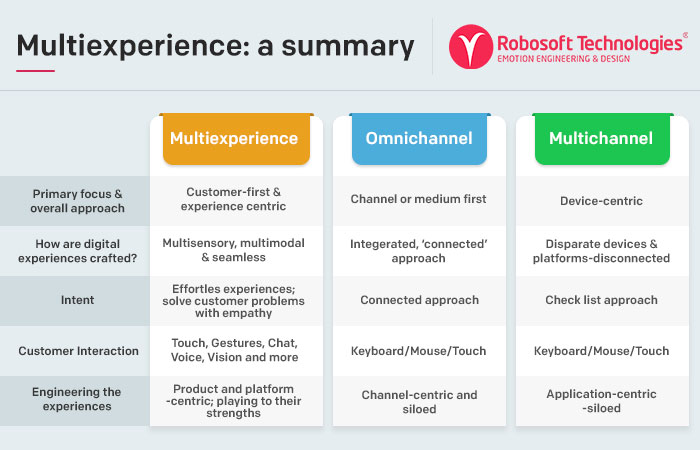
Here’s how retail enterprises can incorporate a multi-experiences strategy for their business:
Design Thinking approach as the starting point
The journey of creating multi-experiences starts from understanding the users and empathizing with them. It calls for a customer journey-centric approach providing multisensory, multimodal, and seamless experiences. Principles of Design Thinking – a human-centric framework can help create solutions to understand customer’s stated and latent needs & pain points and address them.
It is a holistic problem-solving framework that can help businesses create a blueprint, for service delivery to an optimal design experience. This human-centered, iterative design process consists of 5 steps—Empathize, Define, Ideate, Prototype, and Test. At Robosoft, we work with clients through collaborative Design Thinking workshops to identify user pain points, define user journeys and create a product roadmap.
Leverage MXDPs (Multiexperiences Development Platforms)
MADPs (Mobile App Development Platforms) are evolving into MXDPs (Multiexperiences development platforms). According to Gartner’s definition of MXDPs – Multiexperience development involves creating fit-for-purpose apps based on touchpoint-specific modalities, while at the same time ensuring a consistent user experience across web, mobile, wearable, conversational and immersive touchpoints. MXDPs serve to centralize life cycle activities — designing, developing, testing, distributing, managing, and analyzing — for a portfolio of multiexperience apps.
The global multiexperience development platforms market size was valued at USD 6.52 billion in 2019 and is poised to grow at a CAGR of 18.2% from 2020 to 2027.
According to Jason Wong VP, Research & Advisory, Gartner
“We are observing technology changes in mobile app development platforms (MADPs) and in adjacent technology markets where development platform vendors are expanding their value proposition beyond mobile app and web development. This market evolution and platform expansion have resulted in the emergence of multiexperience development platforms (MXDPs) that are used for developing chat, voice, augmented reality, and wearable experiences — as well as mobile and web apps — in support of the digital business.’’
In 2019, Gartner published the Magic Quadrant for Multiexperience Development Platforms. According to which many traditional mobile application development platforms have extended their use cases and offering to meet evolving business needs. This includes capabilities to develop:
- Mobile and web apps, including iOS and Android native mobile apps
- Progressive web apps, and responsive web apps
- Smartphone and tablet apps
- Wearable, AR/VR, IoT, AI apps.
The use cases of MXDPs expand across verticals including healthcare, BFSI, retail, and more.
At Robosoft, we work with clients across sectors offering digital advisory, design strategy, UX/UI services, application development across platforms and devices, and expertise in emerging technologies such as AR, IoT, AI, blockchain, chatbots, and more.
COVID-19 pandemic accelerated the pace of digitization and also reinstated the need for technology partners that can help enterprises to adapt to this rapid change. For the retail industry, the shift of consumers to the online channels will not just continue to rise even after the pandemic is over. Thus, the role of multi-experiences becomes more critical than ever.
MXDPs can help retail enterprises develop web and mobile apps, along with voice, Augmented Reality (AR), chat functionalities, and wearable experience, etc. on a single platform. These experiences created on a single platform can be deployed on various devices as per business and customer requirements.
Retail enterprises will have to create robust and seamless digital experiences within optimized time and cost. Multi experience development platforms can:
- Increase operational efficiencies and improve app development time using streamlined design processes and reusable codes.
- Eliminate the shadow IT, which is a probable security risk that most of the organizations face.
Mapping end-to-end customer journeys
“Experiences are more important than products now. In fact, experiences are products.”~ Brian Solis, digital anthropologist and futurist and an award-winning author
In the experience economy, the customer experience with a brand is a sum of experiences across touchpoints.
‘’Buyers don’t just materialize on your website. Instead, it often requires multiple touchpoints along multiple channels or platforms before they eventually pull the trigger. As a result, it’s also more critical than ever to optimize people’s experience as they move from one platform to the next.’’ ~ Kerry Munro, VP of Ecommerce at Home Depot Canada
When it comes to creating multi-experiences, how seamless the journey is across modalities that consumers prefer plays the most critical role. In this context, mapping a customer journey and delivering experiences around it becomes critical.
In its most fundamental form, a customer journey map begins with compiling a series of user goals and actions into a specific timeline framework. User actions across various use cases can trigger a set of opportunities. If one were to map a similar journey for a food ordering app, it might look like this:

The key elements of any customer journey map will be:
- Persona – The motivations, behavior patterns, pain points, needs, aspirations, and other characteristics of the target audience
- Scenario – defines the situations the journey map addresses that are associated with the goals.
- The Timeline or Journey Phases – A specified time interval from the point of first exposure to the point of achieving the end objective (sale) and all the distinct phases.
- Emotions – The behaviors, thoughts, and feelings the user experiences throughout the journey alongside the phases.
- Touchpoints or Channels – The customer actions while interacting with the brand at different stages and touchpoints in the journey.
- Opportunities – The insights gained from the mapping process and what can be done with these inputs to optimize the customer experience and identify opportunities.
We worked with a restaurant aggregator platform that helps people discover great food joints around them and offer a great dine-out and ordering experience. Though there were many touchpoints in the process, we classified the entire journey into three easy steps – discover, order, and post-purchase experience.
The journey was used to map visual sitemaps and user flows that helped us in designing an intuitive and seamless user experience across touchpoints.

Just mapping the customer journey is not enough. While ensuring experiences for multiple devices, touchpoints, and interaction modalities, that are personalized for individual users, another critical element for the success of the multi-experience strategy is consistency. In fact, according to a McKinsey report consistency on the most common customer journeys is an important predictor of overall customer experience and loyalty.
As rightly said by David Weaver (co-founder of Vintage Cash Cow) –
“A successful customer journey map will give you a real insight into what your customers want and any parts of your product, brand or process that aren’t delivering.”
It is important to understand when, why and which channels do customers use before, during, and after purchase. Customers expect online channels to remember who they are, what they are looking for, and pick up from exactly where they left off irrespective of the channel they choose.
To apply such seamless and consistent multi-experience strategy, Jason Wong, VP, Analyst, Gartner suggests a four-step model:
- Sync me – “You store my information and I can find it
- See me – “You understand my context, my location, my situation, my historical preferences maybe and you give me better information and better interaction”
- Know me – Using predictive analytics to make suggestions to customers
- Be me – “Act on my behalf, I give you permission,” Wong said. “Make the best decision for me – what’s the next best action I should take
Multi-experiences in action
One of the most successful examples of creating multi-experience strategies is perhaps Domino’s pizza which enabled customers to order pizza in 15 different ways from their favorite devices, enabling them to choose whatever interaction modality that is most convenient for the user — voice on google home and messenger, text, smart TV, and more. The objective was to make it more and more convenient for customers to order from Domino’s.
While multi-experiences will help retailers be present across channels that are most comfortable for consumers be it voice, chatbots, AR, etc., innovation will help them stand out. Prior to the pandemic, Samsung launched a Multi-Experience store in Dubai. The store features its products and showcases how its connected device ecosystem works. Product displays are interactive and customer-centric. The in-store customer service department is also enhanced with digital technology. Additionally, the store hosts the educational Galaxy Workshop each evening and has amplified promotions with augmented reality.
Not just FMCG retail but even retail bankers like Commonwealth Bank of Australia have also put a multi-experience strategy in place, giving customers options to connect on 18 channels and offering real-time decisions. To amplify their MX strategy, the bank uses a customer engagement engine that “intelligently suggests and personalizes the next best conversation to have with each customer.”
At Robosoft we worked with one of the leading last-mile delivery service providers to create a customized social media platform that can help F&B retail enterprises create a customized eCommerce solution to transform their social media content into a sales transaction. The platform allows customers to order directly from their Instagram feed, track the order, choose to pay through multiple payment options.
The COVID-19 pandemic accelerated the pace of digital transformation in retail and brought permanent changes to customers buying patterns. To stay ahead and retain customer loyalty it is critical for retail enterprises to evolve from a multi-channel strategy to a multi-experience mindset. This will require adopting a customer-centric approach powered by design thinking principles, leveraging MXDPs, deriving the right insights from customer journeys, and finally using innovation to stand-out and stay ahead of the competition.
‘The task of scaling up Robosoft as a premium brand in the US is exciting’ – meet Brooks Rhinehart, our new President & Country Head, USA.
Since the time we started out in 1996, we at Robosoft have witnessed several growth phases and landmark changes. We were among the pioneers to spot the potential of mobile and offered app development services in 2008. Since then, the digital experience domain has evolved as consumers welcome new technologies and gadgets. Enterprises have to constantly adapt to the changing environment, and we are proud to have played a role in crafting digital experiences across web, mobile, wearables, and more. While we have customers across the world, USA continues to be a critical market for us to meet our growth ambitions. We have had several years of growth, customer success & satisfaction in the US.
Now to take our growth to the next level, we are pleased to welcome Brooks Rhinehart as our President & Country Head – USA.
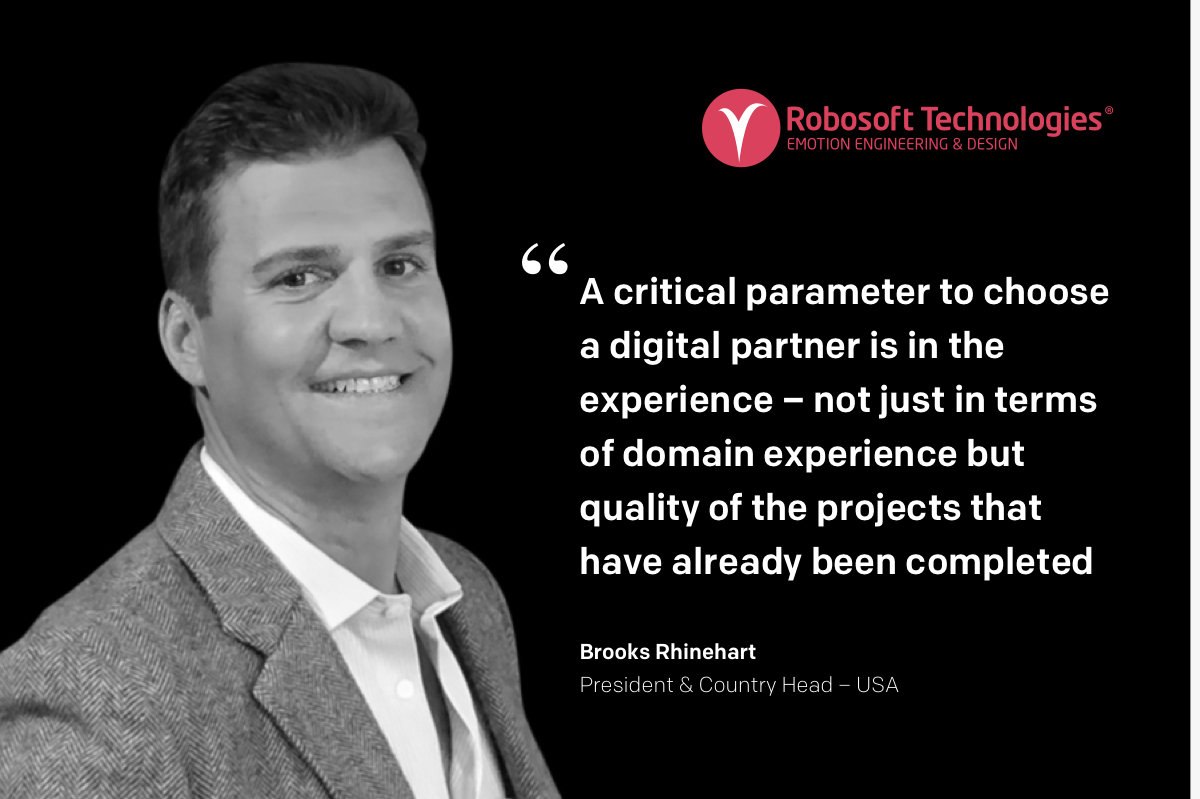
Brooks is a seasoned technology & business development executive with a 360-degree perspective on building digital experiences for enterprises. We had a brief chat with Brooks on his background and challenges CXOs are likely to face in offering digital solutions. Read on:
Q. Welcome aboard, Brooks. Tell us a little bit about your career and journey thus far.
It’s been an interesting and fulfilling journey over the past 20+ years. I started working with technology companies as an Account Executive during the internet boom and subsequent crash in the early 2000s. However, working in the fast-paced start-up world, I was forced to accelerate my understanding of how to navigate complex enterprise organizations and how to clearly articulate to CXO’s or members of leadership at some of the biggest companies at the time. You could probably say it was a case of being young, determined, and I didn’t know what I didn’t know, that helped me succeed, fairly quickly. I had limited experience and mindset that was not filled with a bunch of pre-determined assumptions on how to engage, that I have seen haunt many sales professionals.
Shortly after the internet bust, the entrepreneur inside me saw a few opportunities and investments. I owned a few small companies, was a partner in a multi-state franchise, and learned the hard way the ups and downs of business. As good, and as hard as it was, these types of learnings are something you can’t get from a book, you have to experience them firsthand. I consider myself fortunate to have experienced such as it makes one realize how hard it is to build a brand.
In 2010, I knew mobile was going to be ‘the next big thing’ after as it was close on the heels of the launch of the iPhone and the App Store. There were only a few players in the market at the time as end-to-end service providers in app development. I joined and grew up the ranks in a growth stage B2B tech services company. I spent over a decade there as a partner to enterprises – crafting the digital strategy, creating a roadmap of solutions, and leading the execution of rich customer experiences.
Q. What made you join Robosoft?
Robosoft as a brand has great equity and reputation in India as a top digital partner – rightfully so. In the US, we are not yet in that league, but have worked with some of the most highly sought-after brands and executed many mission-critical projects for them. These projects are not behind the scenes, but massive public-facing projects that most of everyone in the US have seen or might use the services at some point.
Ravi, the CEO and I had many conversations before I decided to come on board, or maybe that he decided I should come on board – but it was clear that we had a connection, not only in business but at a personal level. I was genuinely interested in what he had to say and offer. Many of our conversations had nothing to do with business, and I really enjoyed having the opportunity to see that side of him and not just talk business.
With over 800 employees, the quality of Robosoft’s customers and work was quite impressive. I loved the challenge of scaling up the organization to becoming a premium brand in the US, which is well on its way.
Q. What are the challenges faced by CXOs when it comes to crafting digital solutions in the post-COVID world?
Not as much as everyone would think. The pandemic has created opportunities for all of us. Working remotely and having teams all over the world is nothing new, we just did it in an office. Sure, the hallway conversations can be helpful, but, as we quickly found out, they are not necessary to be successful. That doesn’t mean meeting face to face has lost its value. I still believe in the one-on-one meeting with a handshake – I call this the trust factor, can’t be forever replaced. Nor should it. We all have to stretch our muscles and hold online meetings that we are not used to.
Zoom fatigue is a real thing and we have to be cautious of it. We will have to break up long whiteboarding sessions into smaller timeframes and timelines might get extended, but not by much. We all continue to learn how to be more efficient with our time and how to communicate. This is the ‘new new’ until we can get back to normal but until then, we are able to continue business as usual. And, effectively.
Q. Consumer attention across multiple platforms and devices is a precious goal for enterprises. What are the various steps they can take to gain their attention?
Tough question and there is no one answer to this. We see businesses going back to native experiences instead of web to make sure the customer experience is as good as possible. However, we also see businesses that want to create a simple web experience that is quick and easy to use, without having to download an app. This practice will be widely adopted for companies that know they won’t capture their audience if they require an app download. Or, companies that want to create a simple version of their applications that nails the fundamentals of their needs, you will see many companies adopting this strategy. Think of it as sharp blades, not a swiss army knife. The results are still very compelling.
Q. What are the key factors enterprises should consider when choosing a digital partner?
Time to market: how quickly can you help me get consumers to experience my offering?
Location: do you need full team onsite? While it maybe nice to have is an on-site team mandatory? Given the ‘remote everything’ world we can say ‘geography is history’.
Cost: onshore or offshore, most customers have already been through the development process and are much wiser buyers these days. Stacking a full team onshore is a thing of the past and our buyers expect to have cost savings for development efforts. That doesn’t mean everyone is offshore and the meetings are all early in the morning or late at night, it means, you have a highly functional team that can leverage and translate, the necessary requirements to help contain cost and quality.
Experience: does that mean you need to know everything about a certain vertical? Not at all. If you’re doing transactional data, it’s transactional data – it doesn’t mean that I haven’t done 15 projects in that space, so I’m not qualified. I hear many people expect this and it’s far from practical. The experience is in the quality of the projects that have already been completed. I am not saying that having a specific knowledge in a CMS, EMR or API integrations isn’t important – it is, and can “maybe” save some time. But if you have bad code, bad designs and bad PM’s, you will never be ahead in the end. Possibly, worse off.
Do you like them? Seems odd, but this is a huge factor. If you want a simple website, sure, it doesn’t matter what kind of relationship you have with the vendor. If you are looking to build out a core product or new solution for your company, the relationship is critical. It’s software, things will go wrong, period. It’s how these issues are handled that makes or breaks a relationship. Once you get into a large project, you are somewhat married. Sure, you can get out, but it’s painful. Sometimes, it makes sense to bail but software and it is hard. If anyone tells you differently, I promise it’s not a healthy marriage and you should run.
2020 was a tumultuous year, to say the least, for people and enterprises alike. The global COVID-19 pandemic has disrupted our lives in a manner we never imagined or prepared for. While several industries have been adversely affected (e.g. restaurants, amusement parks, cinema halls) many others have benefited. Digital banking, fintech services, streaming video services, EdTech, online delivery are some of the categories which saw usage surge in 2020.
– In the US, 69.8M homes used OTT in April 2020, an increase of 5.2M homes compared to April 2019.
– 80% of Americans now say they can manage their finances without a physical bank branch.
– Nearly two-thirds of people (65%) ordered food delivery in July 2020.
– Domino’s reported that it received a 22% increase in business from April to May 2020, an enormous spike in demand for the public restaurant industry.
It is believed that many of these behavioral changes are likely to be permanent and change our habits forever. For example, Fintech is viewed as the “new normal” by 73 percent of Americans according to the report commissioned by Plaid, and 67 percent plan to continue managing most of their finances digitally after COVID.
However, as we step into 2021, there are certain other categories where consumers have shown an inclination to ‘go back in time’ as it were. Almost two-thirds of people (63%) have dined in a restaurant during COVID-19, indicating a demand for alternatives to eating at home. Analysts believe that consumers may seek travel experiences of a different kind in the post COVID era. Staycations are already popular in India. Revenge tourism is also said to be a phenomenon leading to ‘flexi hotels’. Travel brands are looking at new modes of revenue. Consumers are conscious of the need to support local businesses such as restaurants, supermarkets, and more. It means there is pressure on them to make the most of digital solutions such as offering curbside pickup and options to order through digital platforms either through aggregators or stand-alone experiences.
In this context, digital experiences have come to play a critical role in creating brand preference. Delivering great customer experiences (CX) has become an imperative step for all enterprises.
Post-COVID era: the Customer Experience imperative
‘People buy from those who they trust’ is an adage that is timeless both in the offline and online world. Whether it is the familiar neighborhood store or a large enterprise in the online world, earning consumer trust has always provided an edge – helping in customer retention and loyalty.
As mentioned by McKinsey,‘particularly in times of crisis, a customer’s interaction with a company can trigger an immediate and lingering effect on his or her sense of trust and loyalty.’
They go on to stress:
Now is also the time for customer experience (CX) leaders to position themselves at the forefront of the longer-term shifts in consumer behavior that result from this crisis. Keeping a real-time pulse on changing customer preferences and rapidly innovating to redesign journeys that matter to a very different context will be key.
The key areas they identify are:
- Focusing on care and connection
- Meeting customers where they are today
- Reimagining CX (Customer Experiences) for a post-COVID-19 world
- Building capabilities for a fast-changing environment
Why is customer experience important?
Customer Experience (CX) is how consumers feel about the brand as a cumulative result of various interactions across touch-points. These could also include offline interactions such as in-store or customer service through chatbots and phone calls.
However, in today’s scenario, the digital experience is perhaps the most dominant factor in customer experience due to the following factors:
Product and service parity: we live in a world where meaningful, real product or service differentiators are hard to come by in most categories. From the humble toothpaste to a luxury hotel, every feature or service can be easily replicated by competition. In businesses that depend heavily on a digital experience to create brand preference, it is even more critical to offer a great CX as a competitive edge.
A bank that has set out to offer a mobile app or a digital-only neo bank are great examples where CX through the digital journey is the only differentiator. 39% of CEOs say customer experience is the most effective method of creating a competitive advantage.
Customer retention vs acquisition: acquiring a new customer can be 5x more expensive than to retain a current customer. In businesses that are subscription-based – such as OTT streaming, aggregator services, and more, design can play a crucial role in customer retention
Impact on bottom line: 84% of companies that work to improve their customer experience report an increase in their revenue. Customers are willing to pay a premium of up to 13% (and as high as 18%) for luxury and indulgence services, simply by receiving a great customer experience.
Multiexperience: what is it and why it should matter to CXOs
The onset of the digital era and the proliferation of digital platforms, channels, and devices led to the concept of multi-channel experience – which essentially meant presence across multiple channels. It was essentially a checklist approach of presence across digital platforms. It later progressed to omnichannel – when such brand experiences were ‘connected’ across channels. Banks and retail enterprises were among those leading the call for such omnichannel experiences as can be seen by their efforts to have a presence through a physical store or branch, a website, and a mobile app.
As devices, platforms and technologies proliferated over the years, consumer habits, dependencies, and expectations changed too. In order to address these changes effectively, Gartner proposed a change in mindset, espousing multiexperience as a new approach.
It calls for a customer journey-centric approach providing multisensory, multimodal, and seamless experiences. It calls for crafting seamless and native experiences across an increasing number of touchpoints – whichever mode the customer is comfortable with. It could be voice, chatbots, personal assistants, wearables, and augmented or virtual reality.
The key is to get all this done without friction and using that platform, touchpoint, or interaction feature to the maximum benefit. At a glance, the difference between multichannel, omnichannel, and multi-experience would look like this:

Viewers are evolving and methods of consuming content are fast changing. Brands today are constantly battling for users’ attention and time. This combined shift in the OTT space led us to the creation of a unified and effortless experience for Discovery Plus. With users owning more than one device, the goal was to design and deliver a consistent experience across devices, regardless of where the user starts, continues, and ends the journey.
In the post COVID world, it is imperative that CXOs embrace the multiexperience mindset and craft effortless and seamless experiences that enable customer delight and win their trust.
The 4-pillars of crafting seamless Multiexperiences
Great products and experiences are the result of meeting latent or overt customer needs through thoughtful design and seamless execution. The four fundamentals of crafting such experiences are:
- Strategy – chart digital roadmaps with a holistic approach keeping in mind consumer needs & business goals
- Design – craft human-centered designs for seamless experiences
- Engineering – elevate the design experience through software and emerging technologies
- Analytics – analyze user data for actionable insights and personalization
Strategy: Chart digital roadmaps with a holistic approach keeping in mind consumer needs & business goals
A plan of action designed to achieve a long-term or overall aim’ is the dictionary definition of strategy. Enterprises must not lose perspective that the overall aim is linked to the business strategy and not just the digital experience. The various elements of the digital experience – be it a website or a native app should help achieve business goals
For example, acquiring new customers as a business goal will warrant a strategy different from say, retaining current customers. Each goal or intent will need a distinct approach in terms of user experience. At the center of any strategy to solve a business problem is the end consumer – the one who has to use a kiosk at an airport terminal, a mobile app to make a payment, or a website to make a booking.
At Robosoft, we use principles of Design Thinking – a human-centric framework that helps create solutions to understand customer’s stated and latent needs & pain points and address them. It can play a role in Services & experience design, Organizational change, Product Design, and more.
Design: crafting the sensory experience for business impact
In today’s world, customer experiences have a direct impact on brand loyalty and ultimately, the bottom line of a business. Tangible, real product differences are hard to come by in most categories or services. For a customer, there is very little to choose in terms of features between one bank and another or one eCommerce portal and another. Better the experience, better the chances of a consumer using the brand. Crafting the right digital strategy, transforming that into an intuitive user experience, and bringing it all alive through robust engineering and cutting-edge technology is what often drives market success.
Experience matters: B2C or B2B
Traditionally, legacy software and interfaces in the B2B domain have been known to be dowdy and poor on aesthetics. Even going beyond mere looks, the web interfaces of government services and many employee-facing digital experiences in enterprises were rarely associated with modern, slick designs that simply worked and delivered a great experience. However, there really should not be any difference between the way digital experiences are crafted – be it in B2B or B2C. Both have to keep the user’s needs at the center and craft a solution that enables them to complete their tasks in an elegant, easy manner.
We should also remember that today’s consumers are accustomed to cutting edge designs and seamless digital experiences in their daily lives thanks to mobile apps for banking, utility services, taxi aggregators, and more. The same consumers expect nothing less when they are at work, using the digital interfaces of enterprises they work for.
At Robosoft, our process of crafting a design solution starts with a deep dive into consumer insights. We conduct bespoke discovery workshops, observe users in the market place to identify pain points that need to be overcome. We partnered with McDonald’s India to redesign their mobile platform and make it the preferred medium for ordering. The vision was to bring the emotions of joy and delight from in-store to the new McDelivery app experience. After multiple store visits, an intense workshop with the client, and a customer experience map, we identified several pain points in the current user journey. This helped us craft a strong intent for the desired experience. The redesigned app garnered 103% more orders than the older app.
Engineering: bringing alive the design experience through technology
No matter how beautiful a design looks, it’s useful only if it works as promised. That’s where cutting edge software skills and years of experience comes into play. Just like fashion, technologies and platforms too have fads. To use a cliché, the only constant is change in the world of technology.
At Robosoft, we believe the role of technology should be to solve a real consumer pain point and should not be seen as a ‘nice to have’ feature just because it is the latest or fashionable to have it.The strategy, design, and engineering teams need to examine the business need of an enterprise and evaluate if there is a relevant role for a particular technology.
Analytics: using data to continuously craft better experiences
The need for Analytics in effectively managing digital product development arises from two perspectives:
(a) continuous improvement is a mantra all digital product teams should believe in and
(b) digital products must meet pre-defined goals and metrics which have an impact on the business.
Steve Jobs famously said, ’Real artists ship’ – emphasizing the need to constantly put out viable products for users to experience and not be hung up on a utopian concept of perfection – which is elusive. Every great product release can have scope for improvement. The second perspective is about measuring one’s success. Peter Drucker is quoted as saying, “you can’t manage what you can’t measure”. Essentially, the analytics team believes in providing actionable insights into user behavior which in turn helps the product management team to continuously improve the product performance.
Some of the key areas in which the analytics team can play a role include:
- Define & Monitor KPIs
- Communicate Performance Results
- Testing & Optimization of Product Features
- Track & Monitor User Feedback
- Create User Cohorts
- User Behavior Analysis
In essence, the 4 pillars to craft great digital experiences include Strategy, Design, Development, and Analytics with a process that is cyclical in nature. An important point to note is that the best of processes and technologies are no substitute for human insights. The ability to identify a relevant, unique consumer insight and applying it to solve business problems through digital experiences is a competitive advantage for enterprises.
At Robosoft, our mission is simplifying lives with delightful digital experiences. Our talented team of product strategists, designers, software engineers work towards driving this mission.
In this interview-based series, we chat with our ‘behind the scenes’ experts – to know more about their values and inspirations. We also try and understand what drives them to create digital solutions that touch the lives of millions and drive business results.
Today, let us get to know Jolene Melita Saldanha, Senior Software Engineer at Robosoft. Jolene started her career with Robosoft and has been a part of our team for over 6 years now.

Q: Can you tell us about yourself – your family, interests, and work philosophy?
I was born in Muscat and was brought up in Mangalore. I have two younger sisters. Being the eldest child of the family comes with a lot of responsibilities. It has taught me to be sensitive towards the needs of others, the value of sharing, and being empathetic. I always strive to follow these learnings in all aspects of my life.
Growing up, I was the nerdy one and the bookworm of the family. Reading has always been my passion and one of my fond childhood memories is going to the book store to pick up novels as my birthday gift. I still try to spend whatever leisure time I have, in reading books. I also enjoy traveling. I always have a plan ready for my next trip. It brings me a lot of joy and gives me an adventure I can look forward to. Traveling is my happy escape. It also helps me to look at life from a completely different perspective. Apart from this, I also love creating travel journals. Revisiting those pictures and the travel experiences brings back happy memories from the trips.
As a professional, I have been an iOS developer for the past 6 years. I have worked on projects for global brands from multiple domains like entertainment, banking, and e-commerce.
Q: What made you choose Robosoft & what is it that inspires you?
I completed my engineering from Sahyadri College in Mangalore. During placements, many companies came but I was reluctant to attend interviews for tech giants. I did not want to be a part of a large enterprise with thousands of employees and lesser opportunities to grow.
I had heard about Robosoft Technologies, a software company in the small town of Udupi, and was fascinated by it. My Seniors who were working there had told me that it was a good company to start your career with, as I would be able to learn all aspects of application development here.
I always wanted to join a company that would give me the opportunity to discover my strengths and build upon them. That is exactly what Robosoft has done for me. When I joined Robosoft, I was put into an iOS development project. I had not learned iOS development in my college and it was a completely new experience for me. I was the only fresher in the team and all the other employees in the project were seniors. They took me under their wings and taught me everything that I needed to know about iOS development. With this began the growth curve of my professional life and I have never looked back.
Robosoft has given me multiple opportunities to learn. I remember in the initial days I was the only employee in Robosoft to work on the watchOS application. I was given an opportunity to work on projects from scratch till the deployment and support phases. This has helped me learn about the complete application development life cycle.
Robosoft has also given me opportunities to directly interact with the customers and understand their expectations from the project. This enabled me to look at the solutions we are working on from both customer and end user’s perspective and not just from a developer’s perspective.
I have also been given the responsibility to mentor my juniors in projects, like I was mentored by my seniors when I joined Robosoft.
Over the years, I have handled multiple projects and have learned many new technologies. I started with learning iOS development with Objective C and now I am working on Swift. From e-commerce platforms to OTT applications, I have handled projects for global brands in multiple domains. The learning opportunities that Robosoft has given me over the years have been endless.
Q: How was 2020 for you? What is it like to manage home and work responsibilities? Any advice to peers?
With lockdowns and extended WFH, 2020 was a difficult year. To a person who enjoys traveling, sitting in a room all day without going out, is quite challenging. I guess none of us had presumed that WFH would last this long. I moved in with my parents when the lockdowns began. Spending time with my family, enjoying small day to day activities like playing badminton together, helping mom in cooking, or enjoying with pets, is how I’ve been spending my time after work.
On the professional front, It’s not easy to work at home without the office environment. There are times when a family member intrudes in between a call with the client or it gets very noisy. But, we have to be patient and realise that it is our WFH schedule that is intruding on the lives of our family and not the other way around. It is important to manage work around the home environment.
Prior to the pandemic when offices were open, I could go to a colleagues’ desk to discuss a particular problem that I’ve been stuck with. Now it’s really difficult to communicate with the teammates just with calls. The most critical thing while working from home is knowing when to stop. Being at home 24 hours, we tend to continue working late in the night as well. Balancing time to spend with family and work is quite challenging. But we need to follow a schedule. I have stuck to a daily schedule and I try to finish my work within that time. Being with family for such a long time after so many years has been a blessing. We never know when we might get this opportunity again.
Q: Your advice to students & freshers exploring opportunities in this field?
Today, almost everyone is online. With access to cheap data and affordable smartphones, the number of people across the globe who have access to the internet has increased exponentially. Digital is no longer a want it has become a basic need for people in their day-to-day lives.
Technologies are also evolving with the needs of the end-user. Those wanting to explore opportunities in this field need to stay updated with the new and emerging technologies. There are a plethora of technologies to learn, it is important to identify which technologies interest them and then gain expertise in that. One way to do that as a student or a fresher is by working on projects related to one’s interests, attending seminars, and learning more about them through online courses. The opportunities in the digital market are immense, but freshers and students need to know what is relevant to the current time and keep themselves updated by learning continuously.
Q: In your view, what is the scope of this industry in the years to come?
Many companies are shifting their focus from traditional channels to connect with their customers to digital mediums. Considering the current COVID crisis, the job market will also increasingly focus on digital and technology skills and remote work will become a standard practice.
In the near future, we will also see the impact of Artificial Intelligence and Voice-based search on our day-to-day lives. Currently, tools like Amazon Echo, Google Home, and Google Instant have become a part of our lives. Even though Voice search is something that has been around for many years, it is only now that it has become less of a novelty and more of a necessity. Soon our lives will be more dependant on such AI-based technologies. So, it is important for enterprises to leverage AI-based solutions to offer better customer experiences. Artificial Intelligence will soon be the biggest opportunity for companies and industries across the globe over the next few decades.
Another technology that will gain momentum will be Extended Reality (XR) – a term that covers several new and emerging technologies that are used for immersive digital experiences. More specifically, it refers to augmented, virtual and mixed reality. These technologies will soon become a way for companies to interact with customers and provide an immersive experience to them.
Experience: 2-3 years
Location: Udupi, Karnataka
Role & Requirement:
- Experience in developing services & web pages using ASP.NET, SQL server, MVC, Entity queries WCF, WebAPI, HTML5, Javascript
- End-to-end understanding of design, development, stabilization, & support of .Net applications
- Create technical documentation as needed
- Participate in technical and operations reviews
- Build and share reusable components
What we are looking for:
A highly creative and experienced designer who is capable of creating amazing user experiences. The candidate must have an eye for artful designs, possess superior UI skills and be able to translate high-level requirements to designs that emotionally connect with the user.
Role & Key Responsibilities:
- Define mobile solution & brand vision in a team
- Collaborate with Design and Engineering teams to define and implement innovative mobile solutions, visuals and experiences
- Execute all visual design stages, from conceptualization to final hand-off to developers
- Create wireframes, storyboards, user-flows, process-flows and site maps
- Drive UI/UX design initiatives with a focus on branding, usability and ensure visual coherence effectively
- Develop mockups and prototypes to effectively communicate visual design ideas & interactions
- Deliver pixel-perfect UI elements.
- Mentor junior designers
Requirements:
- Excellent communication and presentation skills
- In-depth knowledge of Design for mobility – iOS and Android.
- Excellent knowledge on Design software Adobe, Sketch and other prototyping tools
Location: Mumbai & Udupi
What we are looking for:
A highly creative and experienced designer who is capable of creating amazing user experiences. The candidate must have an eye for artful designs, possess superior UI skills and be able to translate high-level requirements to designs that emotionally connect with the user.
Role & Key Responsibilities:
- Define mobile solution & brand vision in a team
- Collaborate with Design and Engineering teams to define and implement innovative mobile solutions, visuals and experiences
- Execute all visual design stages, from conceptualization to final hand-off to developers
- Create wireframes, storyboards, user-flows, process-flows and site maps
- Drive UI/UX design initiatives with a focus on branding, usability and ensure visual coherence effectively
- Develop mockups and prototypes to effectively communicate visual design ideas & interactions
- Deliver pixel-perfect UI elements.
- Mentor junior designers
Requirements:
- Excellent communication and presentation skills
- In-depth knowledge of Design for mobility – iOS and Android.
- Excellent knowledge on Design software Adobe, Sketch and other prototyping tools
- Experience in leading a team
Job Location: Vile Parle (E), Mumbai



